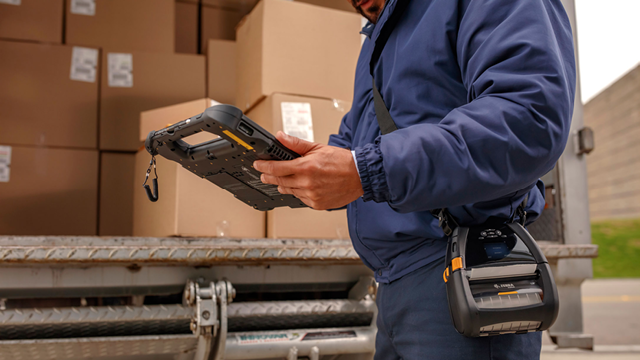When Rapid Reponse and Reliable Access to Information is Mission-Critical
Making the case for rugged mobile tablet solutions for police, firefighters, and EMS workers.
BlueStar's diverse portfolio offers unparalleled access to premium products and services that drive business growth and success. From state-of-the-art hardware to advanced software solutions, our portfolio is designed to empower businesses with the tools they need to thrive in today's competitive landscape.
Our vertical-based content focuses on different industry technologies, solutions, and insights.
A true VAD offers top-notch pick, pack and ship services, and provides programs and services that add value to the distributed products that increase their value or worth.
The BlueStar Difference
Why rugged mobile tablet solutions are pivotal to field services and utility operations.
Field service technicians and mobile utility engineers are most productive when they have all the tools and information they need at a job site. Mobile technology keeps a field team connected to their business’s management system, essential data sources, and applications they need to do their jobs efficiently and effectively.
Additionally, a field tech or engineer with a mobile solution can enhance customer interactions with on-the-spot information about assets, repair history, available times for follow-up appointments, and even generate electronic invoices and receive payment from a mobile device.
Overall, mobile solutions streamline operations far beyond what any manual, paper-based process could do, resulting in more productivity, heightened performance, and customer satisfaction.
Operations in a wide range of industries include field services – from onsite equipment repair, construction and building maintenance, utilities, property services such as landscaping or snow removal, field sales and direct store delivery, and last-time delivery. Although field technicians’ roles can vary from business to business, they all share common characteristics. Field teams travel, sometimes off-road, to reach equipment or customers. Field workers move in and out of vehicles, equipment, weather, and landscapes to retrieve tools, parts, parcels, or merchandise and can’t always predict whether the job site will have reliable network connectivity. Furthermore, the tools they use must be designed for long life and performance in the field.
Operations in a wide range of industries include field services – from onsite equipment repair, construction and building maintenance, utilities, property services such as landscaping or snow removal, field sales and direct store delivery, and last-time delivery. Although field technicians’ roles can vary from business to business, they all share common characteristics. Field teams travel, sometimes off-road, to reach equipment or customers. Field workers move in and out of vehicles, equipment, weather, and landscapes to retrieve tools, parts, parcels, or merchandise and can’t always predict whether the job site will have reliable network connectivity. Furthermore, the tools they use must be designed for long life and performance in the field.

To meet these demands, 62% of organizations are expanding mobile technology, reaching 97% by 2023. Additionally, 46% expect to adapt processes so that they do less than 20% of their work with paper-based systems within that same timeframe.2 The benefits of mobile technology are driving those changes, for example:
Overall, 83% of businesses say mobile technology increases employee productivity and efficiency, and 75% say it enhances customer or partner satisfaction. Also, 57% report it improves order fulfillment accuracy, and 62% attribute an increase in revenues to the transition from paper-based processes to mobile solutions.3
For mobile devices to meet the needs of field services and utility mobile engineering teams, they need to meet the business’ specifications in six key areas:
1. Purpose-built for field services
Mobile devices must be designed and constructed for use in the field. They need to keep performing, even if they experience drops, shocks or vibrations and exposure to temperature extremes. Screens need to be crack-resistant and visible in bright daylight, and touchscreen technology should accommodate users wearing gloves. Devices should also be tested and have ingress protection (IP) ratings that certify they are designed to prevent damage from dust infiltration or splashing or streams of water.
2. Optimal form factor
Field service teams can choose from a range of mobile device options. However, a rugged tablet may be the best option for a screen size that allows techs to easily view the materials they need and interact with applications’ user interfaces. Additionally, tablets give users the opportunity to mount them in vehicles and choose accessories that help protect them and make them easy to carry.
3. The right operating system
Although Microsoft is ending support for Windows Mobile and CE, field service organizations that choose a large form factor mobile device, such as a rugged tablet, have the choice of using Windows 10-based or Android devices to run their mobile applications.4 For companies currently using Windows Mobile or CE, however, the end of support requires an upgrade to a new OS or the risk of security vulnerabilities. Deploying new mobile devices is a prime opportunity to transition to a new operating system.
4. Enterprise security
Deploying hundreds or thousands of mobile devices can introduce an equal number of new network entry points for hackers. Field service organizations must protect their corporate data and network – as well as their customers’ and partners’ data – with security solutions. User authentication, optimally multifactor authentication (MFA), ensures that only authorized personnel can log into mobile devices. Rugged tablets with biometric user authentication tools, such as fingerprint readers or facial recognition, add an extra layer of security, in addition to making logging in easier without having to remember a password.
5. Management and visibility
A successful mobile device deployment is just the beginning of equipping field technicians with the reliable tools to do their jobs productively. Mobile devices must be managed and maintained to ensure they work just as well as they did at rollout. Mobile device deployments must include management solutions that provide intelligent visibility into device usage and status. When you combine visibility with intelligence, you get VisibilityIQ™. VisibilityIQ Foresight™ aggregates your big data onto a single, color-coded, cloud-based pane of glass and translates it into actionable insight to streamline workflow. Zebra OneCare™ offers a cloud-based dashboard that provides status views of your device repair and support information, contracts, case lifecycle, and LifeGuard analytics reports.
6. Connectivity and offline capabilities
Field work can take a team almost anywhere, including where network service is unreliable or not accessible at all. Rugged tablets must include connectivity options, including Bluetooth, 4G or 5G, and Wi-Fi 6E. Workers may also benefit from external antennas mounted on vehicle roofs and pass-through antenna docking modules that allow users to work inside their vehicles.
Realistically, however, mobile devices deployed with field teams should be able to accommodate offline work, with enough computing power and storage to allow downloading maps, manuals, or schematics for offline use.
7. Wired Connection Interface
Depending on the use case, field workers might need to connect their device to some piece of machinery, to some measuring instruments, or to external peripherals. This typically require not only the availability of standard USB-A ports, but also the options to connect Ethernet cables, Serial connectors, audio or video output. Such options need also to be designed from the tablet manufacturer to be robust enough and support several connections/disconnections throughout the life of the device. Zebra™ rugged tablets offer several wired connection options, including the USB, Serial ports or RJ-45 ports embedded in the tablets, or some dedicated dongles offering the required connection options with the highest level of robustness.
2,3 Source https://www.zebra.com/content/dam/zebra_new_ia/en-us/solutions-verticals/vertical-solutions/field-mobility/vision-studies/private/field-operations-vision-study-2019-en-us.pdf
4 Source: Is Windows OS Dead?|Zebra™ https://youtu.be/ajnpQrCcLzs

Mobile solutions and the right accessories and technical support enhance multiple facets of a field service or utility operation.
Rugged tablets are integral to a strategy taking SSEN closer to its business goals.
Scottish and Southern Electricity Networks (SSEN), part of the FTSE-50 energy company, SSE, carry electricity to more than 3.8 million homes and businesses across northern Scotland and central England. It manages 130,000 km of overhead lines and underground cables, 106,000 substations and over 100 subsea cables powering island communities.5
Mobile solutions increase operational efficiency, which can help an organization move closer to net-zero carbon emissions. At the same time, streamlining processes enables SSEN to provide the greatest value to clients, working toward the Office of Gas and Electricity Markets (Ofgem) Revenue=Incentives+Innovations+Outputs (RIIO) price control negotiations in 2023.
A part of SSEN’s strategy was to deploy rugged tablets to optimize data capture, access and reporting. Mobile solutions would also enable real-time visibility into its network, which became increasingly important as more localized and distributed assets became more common, such as solar panels, heat pumps, and battery storage facilities.
Meeting the challenge of keeping its 1,000 mobile engineers connected across thousands of kilometers also required devices capable of withstanding harsh conditions, including weather extremes, travel cross-country, and being carried up pylons and poles.
SSEN chose the Zebra™ L10 rugged tablet with dual SIM-enabled connectivity in remote areas and batteries that keep devices running throughout the shift. It also features a daylight-readable, 10-inch screen that allows engineers to view network designs easily. Thanks to the device’s processing power and storage, they can view a full copy of GIS map data even when working offline. In addition, the L10 camera can capture high-quality images of assets during an inspection.
Among the different options available in the L10 product family, SSEN chose the L10 XSlate in the standard tablet form factor, and powered by the Android OS. This configuration also includes Zebra’s Mobility DNA, giving SSEN the ability to onboard and deploy the Android tablets as well as secure and manage them. The enterprise-ready rugged tablets also feature a standard five-year lifecycle, which can be extended, to help SSEN get the greatest value from its investment.
The Zebra™ L10 rugged tablets immediately demonstrated their value. The rollout of the devices occurred during a period of stormy weather, and the rugged tablets’ performance excelled.
Upon deployment, the tablets enhanced engineers’ workflows. For example, SSEN can send jobs to the engineers via mobile devices, and they have everything they need to complete tasks without stopping at the depot. This new capability lowers mileage and fuel costs and decreases traffic accidents and other hazards from power outages because engineers can arrive more quickly to restore service. Additionally, using rugged tablets has helped mobile engineers enhance interactions with landowners with SSEN assets on their land. They can review maps together on the device and agree upon access.
The L10 has also proven to be a cost-effective solution. If SSEN had chosen a consumer tablet, they’d need to refresh devices about every 18 months. The five-year lifecycle that Zebra™ offers, including a commitment to provide security patches and operating system support, means greater stability.
Furthermore, SSEN’s IT team will use components of Zebra™ Mobility DNA to manage devices. LifeGuard enables IT to control updates, so SSEN can ensure all apps are tested, and the PowerPrecision Console remotely monitors battery usage and health to avoid downtime. SSEN has also opted for a Zebra™ OneCare support contract and a battery replacement service.
SSEN plans to make more apps available to its mobile engineers, including data collection via barcode scanning to locate assets and access data to advance its progress toward paperless operations.
5 Source https://www.zebra.com/content/dam/zebra_new_ia/en-us/solutions-verticals/vertical-solutions/utilities/success-story/utilities-success-story-ssen-en-us.pdf
It’s easy for an enterprise to focus on the challenge at hand, whether it’s a need to operate with fewer employees during a labor shortage or combat rising fuel prices by minimizing trips back and forth to a depot or headquarters. However, by working with a solutions provider with industry expertise, a company can address those issues while enhancing its overall strategy.
For example, rugged tablets that can provide reliable service for five years or more allow a field team to establish and optimize processes that save time and money. Automating processes in the field can also create better employee experiences and reduce turnover – as well as the time and costs to onboard new employees.
Furthermore, decreasing paper use and fuel costs will advance a company’s green initiatives and create a more sustainable operation, helping the enterprise to meet regulatory standards and build stronger relationships with environmentally conscious customers.
Consider the potential for mobile solutions to play a vital role in enterprise-wide initiatives and streamlining processes for field workers. There’s more value from deploying rugged tablets than may be apparent at first glance.
Although enterprises with field teams plan to deploy or refresh their mobile solutions in the coming years, device procurement may pose a challenge as supply chain disruptions continue. BlueStar partners, however, have an advantage.
BlueStar has integrated its technology with supply chain partners, creating a seamless workflow and enabling same-day shipments of more than $100 million worth of IT solutions and equipment.
Additionally, BlueStar’s Value-Add Service Team assists partners in improving margins and gaining a competitive edge with hardware sales. The Value-Add Service Team can also help with software installation, hardware configuration, kitting, custom packaging and labeling.
BlueStar also offers content marketing and lead generation services to help partners build their brands among businesses in their markets, with field teams looking for purpose-built solutions designed to meet the challenges of their industries.
https://reach.bluestarinc.com/zebra-rugged-tablets-offer-at-bluestar
https://connect.zebra.com/tablet_solutions_us_en
https://www.bluestarinc.com/gb-en/value-adds/bluestar-services.html

Making the case for rugged mobile tablet solutions for police, firefighters, and EMS workers.

RFID solutions give T&L operations visibility, track-and-trace capabilities, efficiency, and accuracy that mitigate losses, control costs, and...

Why competitive T&L and warehouse operations are deploying rugged mobile tablet solutions.